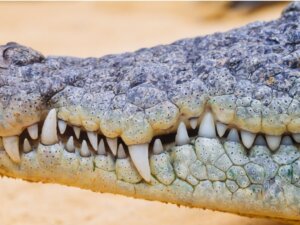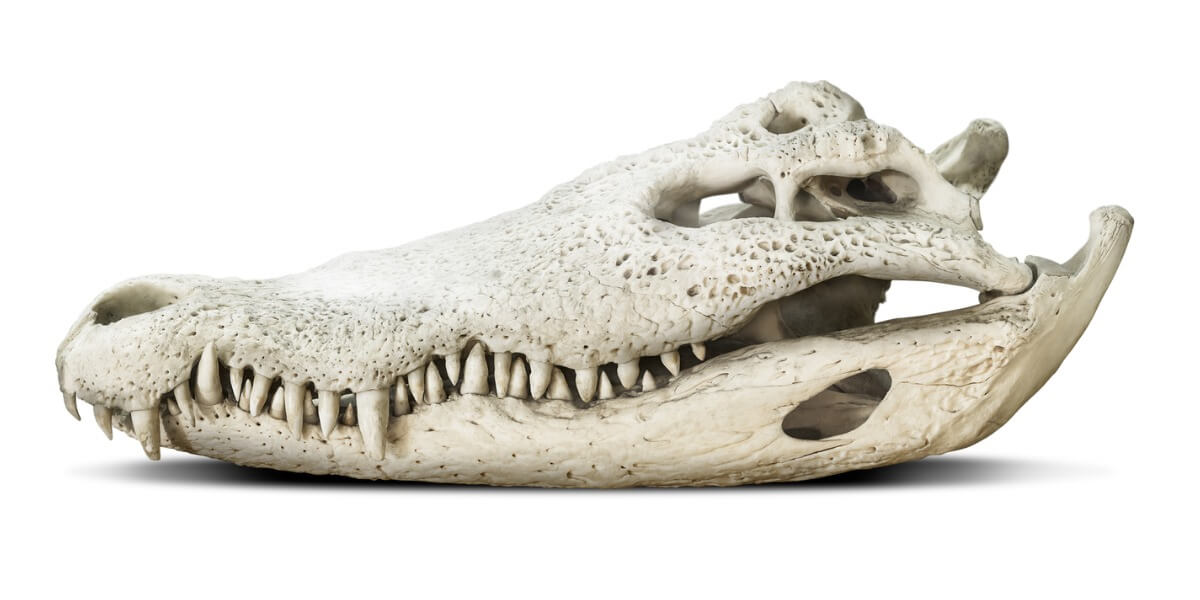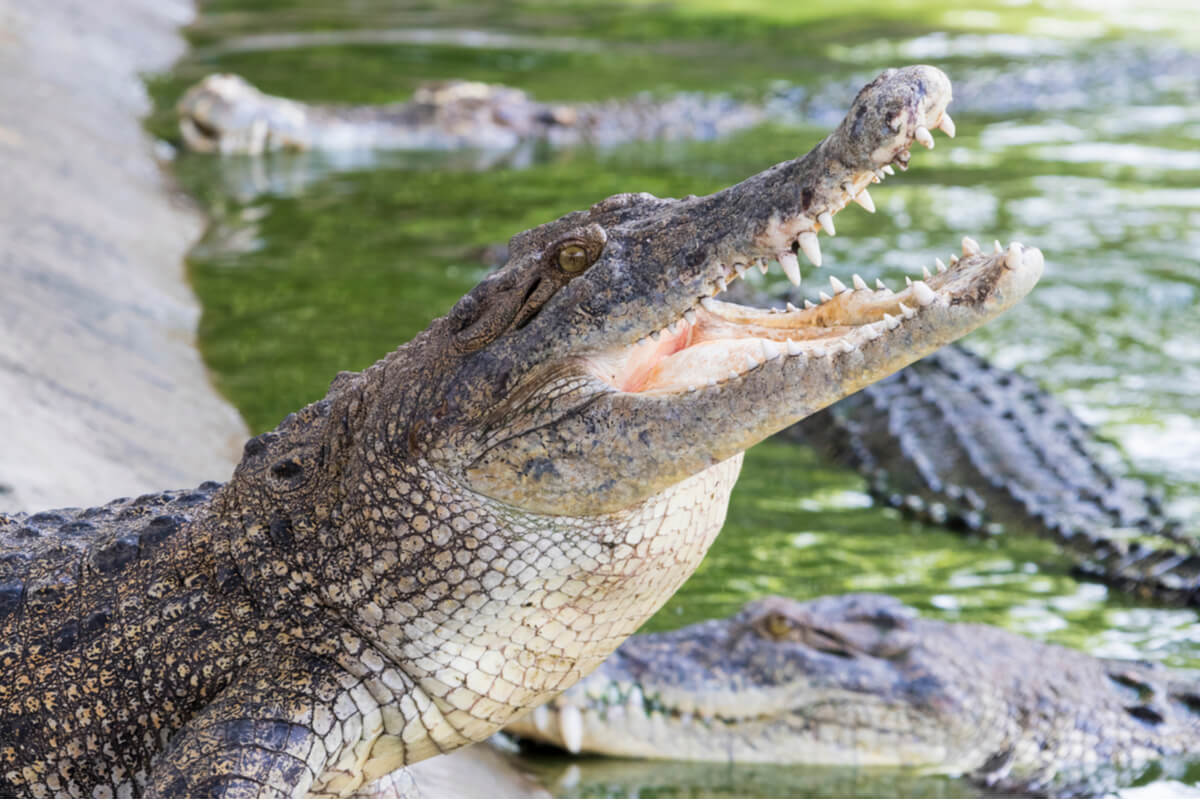Crocodile Teeth: Everything You Need to Know!


Written and verified by the biologist Cesar Paul Gonzalez Gonzalez
Although crocodiles appear to be very calm, these reptiles are capable of rapid movements that include a powerful bite. Find out everything about crocodile teeth in this article!
Despite the great similarity between them, crocodiles are a group made up of 3 different families: Gavialidae (gharials), Alligatoridae (alligators) and Crocodylidae (crocodiles). Although their differences are subtle, they all have jaws with powerful teeth whose structure is the source of their lethality. Read on to learn more about crocodile teeth!
Crocodile jaws
The crocodile’s jaw is designed to capture and hold prey, as its conical teeth easily penetrate the flesh of its victims. In fact, the upper and lower teeth fit perfectly together when they close their mouths. In addition, in the case of gharials and other narrow-nosed animals, their fangs are also quite sharp, which is helpful in their hunts.
As well as the structure of their teeth, the musculature that surrounds the mouth is of the utmost importance for its bite. This means that it takes more than a few sharp teeth to have one of the deadliest bites in existence. However, there’s a slight setback in this system, as the muscles that close the crocodile’s jaw are stronger than those used to open it.
A full-force bite from these animals is capable of destroying even the shells of turtles. However, it only takes a 2-meter long ribbon or bow to prevent them from opening their snouts. This is why an effective method of dealing with them is to secure their jaws with a tie that prevents them from opening.

Do crocodiles shed their teeth?
The most obvious difference between crocodiles and other reptiles is the way in which their teeth fit into their jaws. Far from their teeth merging with their bone, as in acrodonts, they have small alveoli in which their roots are implanted.
Thanks to these structures, if the teeth are damaged they can be moved and replaced as many times as necessary.
The molting and replacement process was described in detail in 1961 by an article in the scientific journal Proceeding of the Zoological Society of London. In this research, it’s mentioned that the tooth begins its process with a small root that grows little by little, while the old one begins to “loosen”. In this way, when fully formed, the new one will emerge, pulling out the old one.
This process is somewhat similar to what happens with teeth change in humans. However, in the case of crocodiles, the mechanism doesn’t stop when they become adults and it occurs several times throughout their lives. For this reason, in the case of a 4-meter-long reptile it’s estimated that it must have already changed all its teeth at least 45 times each.
Crocodiles change their teeth constantly.
Types of crocodile teeth
A crocodile often has differently shaped teeth, which can range from blunt to pointed, almost needle-like silhouettes. In general, these characteristics vary in each species, but a pattern is followed in which reptiles with narrow snouts have the most uniform teeth.
These animals are homodont, which means that all their teeth are the same type and size. Therefore, when talking about the variation in their teeth, reference is made to the differences found between various species. These reptiles’ fangs are related in some way to their diet. The following types are recognized:
- Sharp teeth: These are typical of animals specialized in eating fish, insects, and crustaceans. As some examples, we have the Indian gharial and the Australian freshwater crocodile.
- Blunt teeth: Animals with this dentition specialize in eating hard-shelled mollusks. Examples include the Chinese alligator and the alligator.
- Intermediate teeth: Some species are between the two previous ones, for which they are considered to be more generalists and opportunists. For this reason, they feed on invertebrates, fish, amphibians, other reptiles, and mammals. Some examples of them are the saltwater crocodile and the American alligator.
How many teeth does a crocodile have?
The question is complicated, as there’s no single answer, since the amount varies with respect to the species of crocodile that we’re talking about. In general, most have between 28 and 32 teeth in the upper jaw, while in the lower jaw they have 30 or 40.
The added values give us an approximate number of 58 to 72 teeth on average, although some have more. Again, we emphasize that the dentition is constantly changing, so the number can be variable even between individuals of the same species.
Types of crocodiles and their number of teeth
To give a better understanding of the diversity that exists in their dentures, some species of crocodiles with their respective number of teeth are listed below:
- Black caiman (Melanosuchus niger): has a wide, flat jaw with 72 or 76 teeth.
- Gharial (Gavialis gangeticus): the snout of these animals is narrow, with a set of 100 sharp teeth.
- False gharial (Tomistoma schlegelii): With a jaw similar to the gharials, the jaw of the false gharial is provided with between 76 and 84 sharp teeth.
- American alligator (Alligator mississippiensis): Its wide snout has 80 teeth that protrude from its mouth and are easily visible.
- Saltwater crocodile (Crocodylus porosus): Its powerful jaw features 66 pointed teeth that together are a lethal trap for its victims.
Conservation status of crocodiles
Crocodiles have often faced a series of dangers, as their skin is considered a luxury raw material for the manufacture of various articles. For this reason, true crocodiles (family Crocodylidae) have lost numbers so rapidly that they’re in danger of extinction.
Fortunately, thanks to the internal control and legislation of the countries they inhabit, this situation was regulated, allowing the species to be rescued. However, due to the continuous demand for their skin, other animals such as alligators and caimans were the new target of the industry. In the end, again, this ended up decimating their population and putting them in the same situation as crocodiles.

In addition to this, society perceives these animals as dangerous and aggressive, which is why many people have killed them at the first opportunity. This social conflict prevents efforts to protect them from advancing, as countries often take little action.
It’s true that these animals can put your life at risk, but, in reality, it’s human carelessness and recklessness that leads us to challenge them in their habitat.
Although crocodiles appear to be very calm, these reptiles are capable of rapid movements that include a powerful bite. Find out everything about crocodile teeth in this article!
Despite the great similarity between them, crocodiles are a group made up of 3 different families: Gavialidae (gharials), Alligatoridae (alligators) and Crocodylidae (crocodiles). Although their differences are subtle, they all have jaws with powerful teeth whose structure is the source of their lethality. Read on to learn more about crocodile teeth!
Crocodile jaws
The crocodile’s jaw is designed to capture and hold prey, as its conical teeth easily penetrate the flesh of its victims. In fact, the upper and lower teeth fit perfectly together when they close their mouths. In addition, in the case of gharials and other narrow-nosed animals, their fangs are also quite sharp, which is helpful in their hunts.
As well as the structure of their teeth, the musculature that surrounds the mouth is of the utmost importance for its bite. This means that it takes more than a few sharp teeth to have one of the deadliest bites in existence. However, there’s a slight setback in this system, as the muscles that close the crocodile’s jaw are stronger than those used to open it.
A full-force bite from these animals is capable of destroying even the shells of turtles. However, it only takes a 2-meter long ribbon or bow to prevent them from opening their snouts. This is why an effective method of dealing with them is to secure their jaws with a tie that prevents them from opening.

Do crocodiles shed their teeth?
The most obvious difference between crocodiles and other reptiles is the way in which their teeth fit into their jaws. Far from their teeth merging with their bone, as in acrodonts, they have small alveoli in which their roots are implanted.
Thanks to these structures, if the teeth are damaged they can be moved and replaced as many times as necessary.
The molting and replacement process was described in detail in 1961 by an article in the scientific journal Proceeding of the Zoological Society of London. In this research, it’s mentioned that the tooth begins its process with a small root that grows little by little, while the old one begins to “loosen”. In this way, when fully formed, the new one will emerge, pulling out the old one.
This process is somewhat similar to what happens with teeth change in humans. However, in the case of crocodiles, the mechanism doesn’t stop when they become adults and it occurs several times throughout their lives. For this reason, in the case of a 4-meter-long reptile it’s estimated that it must have already changed all its teeth at least 45 times each.
Crocodiles change their teeth constantly.
Types of crocodile teeth
A crocodile often has differently shaped teeth, which can range from blunt to pointed, almost needle-like silhouettes. In general, these characteristics vary in each species, but a pattern is followed in which reptiles with narrow snouts have the most uniform teeth.
These animals are homodont, which means that all their teeth are the same type and size. Therefore, when talking about the variation in their teeth, reference is made to the differences found between various species. These reptiles’ fangs are related in some way to their diet. The following types are recognized:
- Sharp teeth: These are typical of animals specialized in eating fish, insects, and crustaceans. As some examples, we have the Indian gharial and the Australian freshwater crocodile.
- Blunt teeth: Animals with this dentition specialize in eating hard-shelled mollusks. Examples include the Chinese alligator and the alligator.
- Intermediate teeth: Some species are between the two previous ones, for which they are considered to be more generalists and opportunists. For this reason, they feed on invertebrates, fish, amphibians, other reptiles, and mammals. Some examples of them are the saltwater crocodile and the American alligator.
How many teeth does a crocodile have?
The question is complicated, as there’s no single answer, since the amount varies with respect to the species of crocodile that we’re talking about. In general, most have between 28 and 32 teeth in the upper jaw, while in the lower jaw they have 30 or 40.
The added values give us an approximate number of 58 to 72 teeth on average, although some have more. Again, we emphasize that the dentition is constantly changing, so the number can be variable even between individuals of the same species.
Types of crocodiles and their number of teeth
To give a better understanding of the diversity that exists in their dentures, some species of crocodiles with their respective number of teeth are listed below:
- Black caiman (Melanosuchus niger): has a wide, flat jaw with 72 or 76 teeth.
- Gharial (Gavialis gangeticus): the snout of these animals is narrow, with a set of 100 sharp teeth.
- False gharial (Tomistoma schlegelii): With a jaw similar to the gharials, the jaw of the false gharial is provided with between 76 and 84 sharp teeth.
- American alligator (Alligator mississippiensis): Its wide snout has 80 teeth that protrude from its mouth and are easily visible.
- Saltwater crocodile (Crocodylus porosus): Its powerful jaw features 66 pointed teeth that together are a lethal trap for its victims.
Conservation status of crocodiles
Crocodiles have often faced a series of dangers, as their skin is considered a luxury raw material for the manufacture of various articles. For this reason, true crocodiles (family Crocodylidae) have lost numbers so rapidly that they’re in danger of extinction.
Fortunately, thanks to the internal control and legislation of the countries they inhabit, this situation was regulated, allowing the species to be rescued. However, due to the continuous demand for their skin, other animals such as alligators and caimans were the new target of the industry. In the end, again, this ended up decimating their population and putting them in the same situation as crocodiles.

In addition to this, society perceives these animals as dangerous and aggressive, which is why many people have killed them at the first opportunity. This social conflict prevents efforts to protect them from advancing, as countries often take little action.
It’s true that these animals can put your life at risk, but, in reality, it’s human carelessness and recklessness that leads us to challenge them in their habitat.
All cited sources were thoroughly reviewed by our team to ensure their quality, reliability, currency, and validity. The bibliography of this article was considered reliable and of academic or scientific accuracy.
- Iordansky, N. N. (2000). Jaw muscles of the crocodiles: structure, synonymy, and some implications on homology and functions. Russian Journal of Herpetology, 7(1), 41-50.
- Walmsley, C. W., Smits, P. D., Quayle, M. R., McCurry, M. R., Richards, H. S., Oldfield, C. C., … & McHenry, C. R. (2013). Why the long face? The mechanics of mandibular symphysis proportions in crocodiles. PLoS One, 8(1), e53873.
- Erickson, G. M., Gignac, P. M., Steppan, S. J., Lappin, A. K., Vliet, K. A., Brueggen, J. D., … & Webb, G. J. (2012). Insights into the ecology and evolutionary success of crocodilians revealed through bite-force and tooth-pressure experimentation. PLoS One, 7(3), e31781.
- Enax, J., Fabritius, H. O., Rack, A., Prymak, O., Raabe, D., & Epple, M. (2013). Characterization of crocodile teeth: correlation of composition, microstructure, and hardness. Journal of Structural Biology, 184(2), 155-163.
- Ruiz-Omeñaca, J. I., Pereda-Suberbiola, X., & Belinchón, M. (2010). Dientes de arcosaurios (Crocodyliformes, Theropoda) del Jurásico Superior de Buñol (Valencia). Geogaceta, 48, 35-38.
- Poole, D. F. G. (1961, January). Notes on tooth replacement in the Nile crocodile Crocodilus niloticus. In Proceedings of the Zoological Society of London (Vol. 136, No. 1, pp. 131-140). Oxford, UK: Blackwell Publishing Ltd.
- Prasad, G. V., & de Broin, F. D. L. (2002, January). Late Cretaceous crocodile remains from Naskal (India): comparisons and biogeographic affinities. In Annales de Paléontologie (Vol. 88, No. 1, pp. 19-71). Elsevier Masson.
- Legasa, O., Buscalioni, Á. D., & Gasparini, Z. (1993). The serrated teeth of Sebecus and the iberoccitanian crocodile. A morphological and ultrastructural comparison.
- Endo, H., Aoki, R., Taru, H., Kimura, J., Sasaki, M., Yamamoto, M., … & Hayashi, Y. (2002). Comparative functional morphology of the masticatory apparatus in the long‐snouted crocodiles. Anatomia, Histologia, Embryologia, 31(4), 206-213.
- Morris, M. (1989). Tooth and Claw: Tales of Survival and” Crocodile Dundee”. Social Text, 105-127.
This text is provided for informational purposes only and does not replace consultation with a professional. If in doubt, consult your specialist.








